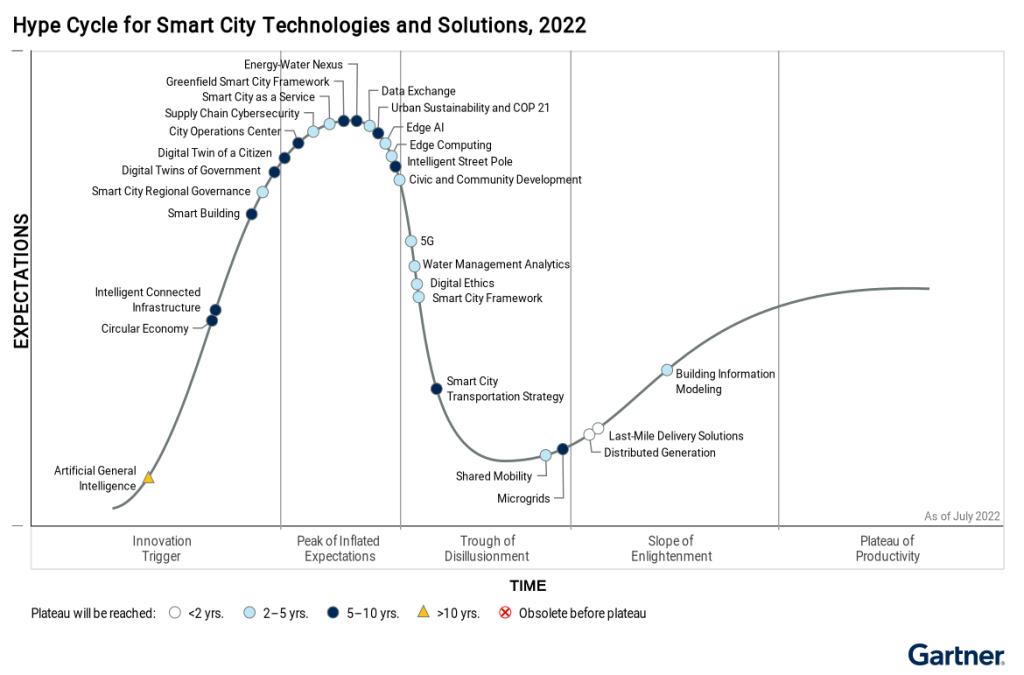
Hype Cycle™ for Smart City Technology and Solutions, 2022: Report from Gartner®
Hype Cycle™ for Smart City Technology and Solutions, 2022: Report from Gartner®
Aimed at people in governments who are responsible for delivering sustainable societal outcomes in cities, the latest Gartner report supports assessment of emerging technologies, solutions, practices, and principles.
What is the Gartner Hype Cycle?
Gartner Hype Cycles provide a graphic representation of the maturity and adoption of technologies and applications, and how they are potentially relevant to solving real business problems and exploiting new opportunities.

Each Hype Cycle drills down into the five key phases of a technology’s life cycle
Innovation Trigger: A potential technology breakthrough kicks things off. Early proof-of-concept stories and media interest trigger significant publicity. Often no usable products exist and commercial viability is unproven.
Peak of Inflated Expectations: Early publicity produces a number of success stories — often accompanied by scores of failures. Some companies take action; many do not.
Trough of Disillusionment: Interest wanes as experiments and implementations fail to deliver. Producers of the technology shake out or fail. Investments continue only if the surviving providers improve their products to the satisfaction of early adopters.
Slope of Enlightenment: More instances of how the technology can benefit the enterprise start to crystallize and become more widely understood. Second and third generation products appear from technology providers. More enterprises fund pilots; conservative companies remain cautious.
Plateau of Productivity: Mainstream adoption starts to take off. Criteria for assessing provider viability are more clearly defined. The technology’s broad market applicability and relevance are clearly paying off.
Data exchanges will be foundational in transforming city experiences
Gartner research finds that “the roadmap of smart city services is based on an orchestrated use of data sources and collaboration”. In the context of a “new movement focused on the human centricity of smart city efforts” and pandemic recovery funds, Gartner expects continued smart city efforts in the coming years, and that these advances are “refocusing with key underpinning concepts of sustainability and equity”.
The research finds that “Many technologies have a transformational or high impact on smart cities, but will take a longer time to achieve their benefits. As a result, city CIOs and urban planners will implement the solutions over longer periods to generate outcomes and ROI. Many of the benefits can be supported using data analytics and data exchange to optimize city operations, along with the intelligent urban ecosystem, or to drive long-term sustainable and inclusive outcomes.
Innovations like data exchanges will provide transformational experiences to city services and will become mainstream in the next five years. Becoming mainstream means that the rapid increase of automated transactions will support contextualization of service delivery at the location where the service is needed. For example, this acceleration is needed for smart buildings and city operations centers. Those will be maturing, along with the circular economy, in 10 years or less.
High benefits will be generated in up to five years from innovations such as 5G, in conjunction with building information modeling in smart buildings and campuses. CIOs will require those technologies to capture and analyze data for operational efficiency (for example, in transportation and shared mobility), and for energy and resource management. Digital representation of urban situations through digital twins will show benefits over an extended time period of up to 10 years, as joint governance on urban objectives and vision turn into actionable roadmaps.
Gartner, Hype Cycle for Smart City Technologies and Solutions, 2022, Bettina Tratz-Ryan, Bill Finnerty, 22 July 2022
Gartner and Hype Cycle are registered trademarks and service marks of Gartner, Inc. and/or its affiliates in the U.S. and internationally and are used herein with permission. All rights reserved.
This graphic was published by Gartner, Inc. as part of a larger research document and should be evaluated in the context of the entire document. The Gartner document is available upon request from here. Gartner does not endorse any vendor, product or service depicted in its research publications and does not advise technology users to select only those vendors with the highest ratings or other designation. Gartner research publications consist of the opinions of Gartner’s research organization and should not be construed as statements of fact. Gartner disclaims all warranties, expressed or implied, with respect to this research, including any warranties of merchantability or fitness for a particular purpose.
About the Center of Expertise
Microsoft’s Public Sector Center of Expertise brings together thought leadership and research relating to digital transformation in the public sector. The Center of Expertise highlights the efforts and success stories of public servants around the globe, while fostering a community of decision makers with a variety of resources from podcasts and webinars to white papers and new research. Join us as we discover and share the learnings and achievements of public sector communities.
Questions or suggestions?






